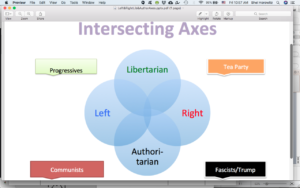How We Motivate Sanders Supporters to Vote in November?

Yesterday and today, I’ve listened to a bunch of the EarthDayLive2020 conference. It’s exciting to see this intergenerational, intercultural, and very smart group of activists and performers attracting thousands of viewers over Zoom.
One speaker, Erica Chenowith, tossed off a remark that changed everything I think about the 2020 US presidential election. She said—and this is so clear after all the progressives exited the race—that we get involved with this election not to choose our ally but to choose our adversary (she used the term “enemy,” but I think my term gets her meaning more accurately).
This, to me, might be the secret sauce for getting progressives to come out and vote. In this scenario, Biden migrates from lesser evil to far, far better adversary. With a moderate and relatively honest Democrat in the White House, progressives will have a much easier time moving our agenda forward. Biden will be more pliable on economic issues, on the social safety net, and on the environment. He is no Bernie Sanders or Elizabeth Warren, but he is someone who does listen, and who occasionally changes his mind—as he did on same-sex marriage. In the Bill Clinton era, he supported the horrid DOMA, but he pushed Obama well to the left when marriage equality came to the tipping point.
He is already likely to reinstate the US into the Paris Climate Accord. Once he understands how the Green New Deal will create jobs, put discretionary spending into people’s pockets, and reduce our vulnerability both to foreign oil oligarchs and to runaway multinational corporations—thus reducing the risk of war—I think he would support it or at least not interfere with it.
And while the Obama administration, where he was VP, had a poor record on immigration justice, the cruelty that DT has consistently shown to immigrants and refugees is orders of magnitude worse. I saw this with my own eyes in a week volunteering at the US/Mexico border in February; my wife wrote this piece about it.
In other words, a Biden administration would be a much more welcome adversary. It would be more humane, more willing to work with other countries, interested in preserving rather than destroying the environment—and far more predictable. And it would be a complete rejection of the apparent main goal of the current occupant: to make himself even richer and everyone else be damned. In other words, Biden will be someone who will respond as we would like him to, at least some of the time—and who is unlikely to ever engage in the viciously destructive hate-based politics we see every day.
There’s ample precedent. LBJ, the long-time Southern politician, not JFK, the liberal icon, was the one who signed several pieces of civil rights legislation and declared war on poverty. Richard Nixon, a Republican and anticommunist extremist, was probably the president who did the most to protect the environment other than perhaps Obama–not because he believed in the cause, but because public outcry left him no other choice. (Of course, the good work Johnson and Nixon did on these issues in no way gives them a pass around the Vietnam war, domestic repression, etc.)
I’d love to hear from progressives who take electoral politics seriously—is this the way we attract young disillusioned progressives who are ready to sit out the election because we are once again stuck with a centrist candidate who doesn’t really represent us? Please weigh in



